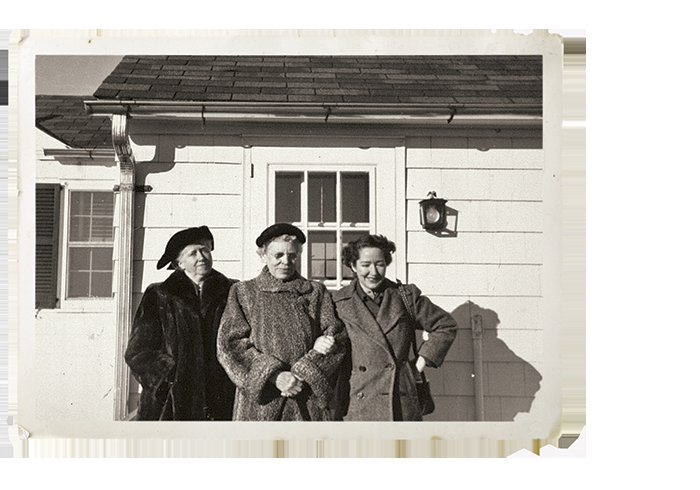Hidden Carlisle: Where Marianne Moore Walked

Photo of Marianne Moore (far left) from Archives & Special Collections.
by Jeff Wood '85
On a Sunday morning in June 1905, Mary Warner Moore and her two adult children walked to church in downtown Carlisle, Pa. Older brother Warner Moore was home from Yale University. Marianne, who would go on to become one of Modernism’s most acclaimed poets, was 17 and a new graduate of Metzger College (founded as a women’s school through the estate of George Metzger, Dickinson class of 1798). She was preparing to enter Bryn Mawr in the fall. When the family walked out their house at 343 N. Hanover Street, Metzger College loomed in all its huge gabled and awning’d glory across the street. Mary Warner Moore taught there. The family turned left, headed south.
Carlisle, a small central Pennsylvania county seat in 1905, a compact grid of an old frontier town in an agricultural valley, received and held the world for the Moore family. They crossed North Street, down which in five years Bryn Mawr and Carlisle Commercial College graduate Marianne would ride her bike to teach at the Indian Industrial School at Carlisle Barracks.
They entered the main business district of the town. In the six blocks between home and church, the Moores would pass nine grocers, in addition to two fruit sellers and one butcher. They passed one saloon, a whole liquors shop and two hotels. They walked by three harness shops, a bakery, a candy store, an ice cream parlor, four dry goods stores, one general store, three furniture stores and one wallpaper store. On their way to spiritual edification they passed four barbers, three doctors, three drug stores and two tobacconists. Two banks and two jewelers represented the apex of the thriving market town. Marianne in later life would be caricatured in her fame for her love of hats, from a dashing Cordobes flat hat to a colonial tricorne with cape ensemble. Much serious academic and psychological speculation would be written on her assertion of sartorial style in relation to her Modernist poetry. On this typical stroll to church, Marianne passed six millinery shops.
When they crossed Locust Alley they could have looked east, to see a few dozen yards away the most notable brothel in town, a post-Civil War business that would be passed through three generations of African-American women. At the center square, they were in a great public space of two churches (Episcopal and Presbyterian), a courthouse and an immense Market House. They may have looked west down High Street as they crossed the square, glimpsing the town’s book store, more hotels, the new public library and Dickinson College in its distant verdant coolness.
They passed them all by. They walked a block farther south to the Second Presbyterian Church on the southeast corner of S. Hanover and Pomfret streets. There they entered in the largest Protestant congregation of the town, helmed for decades by the Rev. George Norcross. Norcross, scholar, historian and possessor of the largest private library in the Cumberland Valley, not only was a pillar of the progressive community in town, but he and his wife had four daughters.
He had the family—lively, vivacious, well-read, fearless—that the Moores dreamed of in their brokenness, their mannered reserve that took in a few close friends but kept many more at a distance. The Norcross family home at 243 S. Hanover Street served as counterweight to the quiet of the Moores’ home at the other end of the street. It was Marianne’s intellectual salon and a gateway to the world that would later celebrate her sophisticated and allusive poetry and essays.
“An unfanatical innate love of books, music, and ‘art,’ made Blake, Rembrandt, Giotto, Holbein, D.G. Rossetti and Christina Rossetti, Turner, Browning, Ruskin, Anthony Trollope, George Meredith, household companions of the family and friends,” Marianne wrote in 1963, long after she had left Carlisle in 1916. “We were constantly discussing authors. When I entered Bryn Mawr, the college seemed to me in disappointing contrast—almost benighted.”
But as rich as the world of Carlisle was, as significant in shaping Marianne from age 8 upon her arrival to 28 upon her departure, the larger world beckoned, a larger and longer and more heralded walk to be taken.
Jeff Wood ’85 is the owner of Whistlestop Bookshop in downtown Carlisle. He recently followed up his Dickinson American studies degree with a master’s in American studies from Penn State University.
Learn more
Published April 25, 2016